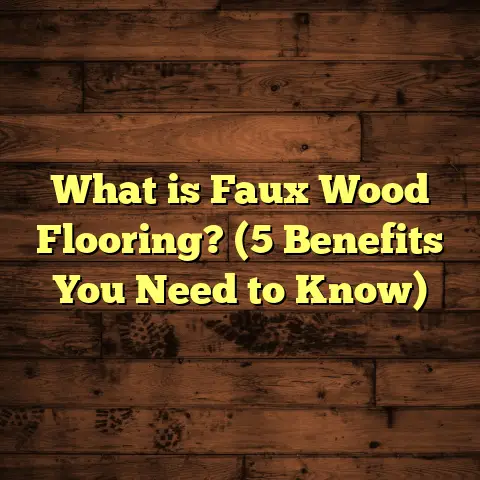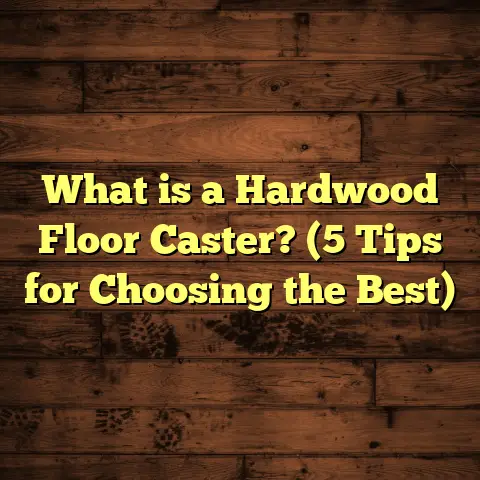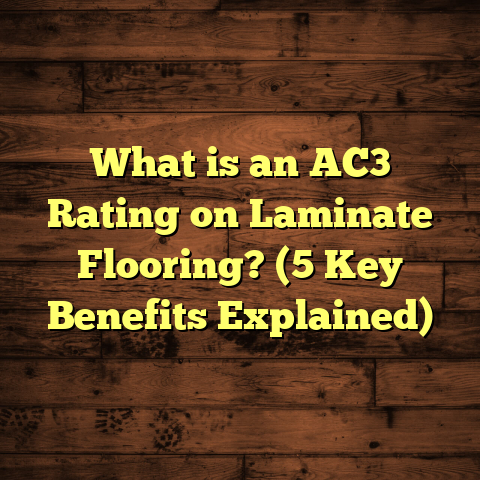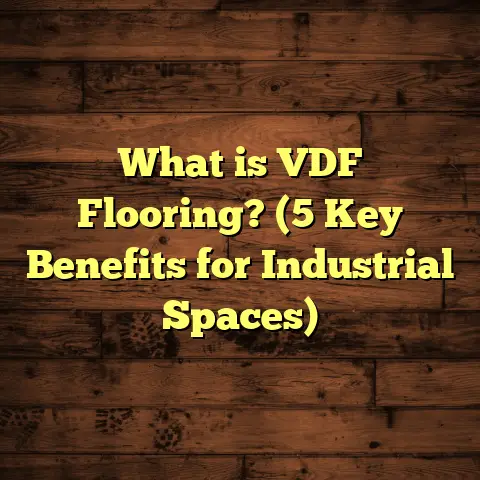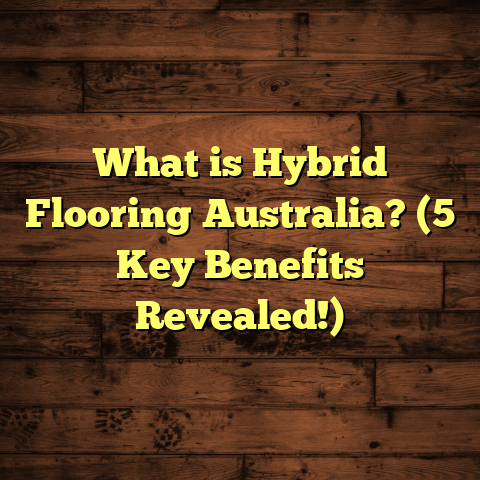What is Cheaper: Carpet or Vinyl Plank Flooring? (5 Key Comparisons)
Craftsmanship is something I’ve come to deeply appreciate over the years of working in flooring. It’s not just about laying down material; it’s about precision, attention to detail, and understanding how every choice affects the comfort and style of a home. I remember early in my career, spending hours perfecting a laminate installation, only to realize the importance of choosing the right material for the right room. That experience shaped how I help clients decide between options like carpet and vinyl plank flooring.
What is Cheaper: Carpet or Vinyl Plank Flooring?
If you ask me, this question is a bit like asking what kind of coffee is cheaper: espresso or drip? Both serve a purpose, but pricing depends on several factors. Carpet and vinyl plank flooring are two popular choices in residential spaces, each with its own cost structure, benefits, and drawbacks. When homeowners ask me, “What’s cheaper?” I always say, “Let’s break it down.”
Carpet is a textile floor covering made from woven or tufted fibers, offering warmth and softness underfoot. Vinyl plank flooring (often called luxury vinyl plank or LVP) mimics the look of hardwood but is made from synthetic materials designed to be durable and water-resistant.
I want to share insights from my years installing these floors, backed by data and practical experience. Let’s compare carpet and vinyl plank flooring using five key points: upfront costs, installation, durability and maintenance, lifespan, and overall value.
1. Upfront Material Costs
When you’re budgeting for new flooring, material costs are often the first thing that catches your eye.
Carpet
Carpet prices can vary widely depending on fiber type and quality. Basic nylon or polyester carpets cost anywhere from
$1 to $3 per square foot for materials alone. Mid-range carpets with better stain resistance and padding run between
$3 and $5 per square foot. High-end wool carpets or designer brands can soar above $8 per square foot.
I once worked with a couple who wanted a budget-friendly option for their kids’ playroom. They picked polyester carpet at the $1.50 per sq ft mark. It looked fine initially but faded faster than expected under heavy use. This experience taught me that going too cheap can sometimes mean replacing sooner.
Vinyl Plank Flooring
Vinyl plank materials generally cost between
$2 and $7 per square foot. Entry-level vinyl planks are often priced around $2-$3, while premium, thick-core planks with realistic wood textures can reach $5-$7 per square foot.
A memorable job involved installing high-end vinyl plank in a kitchen remodel. The homeowner loved the wood look without worrying about water damage—a key factor in her decision despite the slightly higher price tag.
Breaking Down the Numbers:
| Flooring Type | Material Cost Range (per sq ft) |
|---|---|
| Carpet | $1 – $8+ |
| Vinyl Plank | $2 – $7 |
Padding Costs
An important note: carpet usually requires padding underneath for comfort and durability. Padding adds roughly
$0.50 to $1.00 per square foot to the material cost. Vinyl plank flooring typically doesn’t need padding as many types have built-in underlayment.
So for a 500 sq ft room:
- Basic carpet (material + padding): 500 × ($1.50 + $0.75) = $1,125
- Mid-range vinyl plank: 500 × $4 = $2,000
The vinyl plank looks pricier upfront here, but as you’ll see later, other factors balance this out.
2. Installation Costs and Complexity
Installation makes a big difference in total project costs. Here’s how I usually explain it:
Carpet Installation
Carpet installation involves laying down padding, stretching the carpet to avoid wrinkles, and attaching it securely to tack strips around the room perimeter. Labor tends to run from
$1.50 to $3.50 per square foot depending on room complexity.
Older homes can present challenges—uneven subfloors require extra prep work. I remember one job where an old carpet had to be removed first, which added $500 to the bill. This is common if you’re replacing an existing floor.
Seams also matter—larger rooms require seams that need to be expertly joined to avoid visible lines or tripping hazards.
Vinyl Plank Installation
Vinyl plank flooring often features a click-lock system that makes it easier for installers—and sometimes even DIYers—to handle. Labor costs typically range from
$1.50 to $4 per square foot.
However, subfloor preparation is crucial with vinyl planks. If your floor isn’t level or has moisture issues, expect extra prep costs.
I once helped a client with a basement that had moisture problems beneath the concrete slab—it delayed installation until we could install a vapor barrier and level the floor properly, adding about $800 in prep costs.
Comparing Installation Complexity
| Flooring Type | Typical Labor Cost (per sq ft) | Installation Notes |
|---|---|---|
| Carpet | $1.50 – $3.50 | Requires padding; stretching; tack strips |
| Vinyl Plank | $1.50 – $4 | Subfloor prep critical; click-lock often easier |
My Take:
Installation costs for carpet and vinyl plank flooring often fall in similar ranges, but vinyl plank can sometimes be more expensive due to subfloor prep demands. On the flip side, carpet installation requires skill to stretch properly, or you risk bubbles.
3. Durability and Maintenance Costs
How long your floor lasts and what it costs to keep it looking good can heavily influence your final budget.
Carpet Durability
Carpet wears out faster than vinyl plank flooring, especially in high-traffic areas. Polyester carpets are prone to matting and stains; nylon fares better but still shows wear over time.
Maintenance involves regular vacuuming plus professional cleaning every 12-18 months at about
$0.20-$0.40 per square foot.
I remember advising a family with kids and pets: carpet held warmth but stained easily, leading them to replace it sooner than anticipated.
Vinyl Plank Durability
Vinyl plank flooring is known for its resistance to scratches, stains, and moisture—making it a favorite in kitchens and bathrooms. It typically requires only sweeping and occasional mopping.
Maintenance costs are minimal—usually under $0.05 per square foot annually if you do your own cleaning.
In one project for a rental property owner, they chose vinyl plank because their tenants frequently spilled drinks and tracked dirt inside. The floors stayed pristine longer than carpet ever would have in that setting.
Wear Resistance
Vinyl planks have wear layers measured in mils (thousandths of an inch). Residential-grade planks usually have a 12–20 mil wear layer; commercial planks can go up to 40 mils. Thicker wear layers mean better scratch resistance.
Carpet durability depends on fiber type:
- Nylon: Good abrasion resistance
- Polyester: Moderate
- Olefin: Lower resistance; prone to crushing
4. Lifespan
How long your floor lasts before needing replacement impacts what you pay per year of use.
Carpet Lifespan
Most carpets last about 5-15 years depending on quality and care. Lower-grade carpets tend toward the lower end of that range.
High-traffic areas might need patching or spot replacement sooner than full replacement.
Vinyl Plank Lifespan
Good-quality vinyl plank flooring lasts 15-25 years or more with proper installation and care.
Here’s a quick calculation I often share with clients:
| Flooring Type | Avg Cost (Material + Installation) | Avg Lifespan (Years) | Cost Per Year |
|---|---|---|---|
| Carpet | $4 per sq ft | 10 | $0.40 |
| Vinyl Plank | $6 per sq ft | 20 | $0.30 |
That means even though vinyl plank might cost more upfront, it often works out cheaper over time when you spread out the investment.
5. Overall Value: Comfort vs Functionality
This one’s personal but important:
- Carpet offers warmth and softness underfoot—great for bedrooms and living rooms where comfort matters most.
- Vinyl plank flooring provides a sleek look that mimics hardwood but resists moisture and damage—better for kitchens, bathrooms, or busy households.
I’ve installed both in various homes and heard clients say things like:
“I love how cozy my carpet feels in the den.”
“Vinyl plank saved me when my dog spilled water repeatedly in the kitchen.”
Choosing what’s cheaper depends on what you prioritize—initial cost, long-term durability, or comfort.
Digging Deeper: Factors Affecting Cost Differences
There’s no one-size-fits-all answer here because many variables influence cost comparisons between carpet and vinyl plank flooring.
Regional Price Variations
Where you live affects labor rates and material availability significantly.
In some urban areas, labor can be twice as expensive as rural locations due to wage differences and demand for skilled installers.
Material costs also vary based on local suppliers’ inventory and shipping fees.
I once worked in two cities within 100 miles of each other where vinyl plank cost differed by almost 20%. That changed recommendations for clients depending on their budget flexibility.
Room Size & Shape
Smaller rooms with odd angles or irregular shapes increase installation costs due to more cuts and seams needed—especially for carpet stretches or vinyl plank layouts requiring precise fitting.
Larger open spaces might favor vinyl plank because installation is quicker with click-lock systems compared to stretching carpet evenly over wide areas.
Condition of Subfloor
If your subfloor has damage or moisture issues:
- Vinyl plank may require moisture barriers or leveling compounds.
- Carpet installation might need removal of old flooring or repair of damaged wood/plywood beneath.
These prep steps add surprise expenses if not planned ahead.
Real Client Case Studies
Case Study 1: Family with Pets
A client with two dogs wanted durable floors that were easy to clean yet comfortable enough for their kids’ playroom.
They initially leaned toward carpet for coziness but worried about stains from pets.
After discussing pros/cons and showing examples of vinyl plank’s scratch resistance plus softer underlay options, they chose mid-range vinyl plank with an attached cushion pad.
Outcome:
Three years later they reported no stains or damage despite pet accidents—a huge relief compared to previous carpet floors they replaced twice in five years.
Case Study 2: Senior Couple Retiring in Their Home
This couple wanted soft flooring in bedrooms for comfort but preferred easy maintenance in common areas like hallways & kitchen.
We recommended plush nylon carpet in bedrooms for warmth plus waterproof vinyl plank in kitchen/hallways for durability.
Their budget balanced out by mixing materials strategically rather than going all carpet or all vinyl plank everywhere.
Maintenance Tips I Share Often
For Carpet
- Vacuum multiple times weekly in high traffic zones.
- Use carpet protectors under heavy furniture.
- Schedule professional cleaning every year.
- Address spills immediately with proper spot cleaners.
- Rotate rugs/furniture occasionally to minimize wear patterns.
For Vinyl Plank Flooring
- Sweep or vacuum regularly to prevent grit buildup.
- Mop with manufacturer-approved cleaners.
- Avoid abrasive tools that could scratch surface.
- Use felt pads under furniture legs.
- Clean spills promptly but no need for deep cleaning unless very dirty.
Environmental & Health Considerations
Carpet can trap dust mites and allergens if not cleaned regularly, which affects indoor air quality—a concern for allergy sufferers in many homes I’ve worked on.
Vinyl plank flooring usually doesn’t harbor allergens but may off-gas VOCs (volatile organic compounds) initially after installation depending on brand/type.
I encourage clients sensitive to chemicals to look for low-VOC certifications like FloorScore or GREENGUARD Gold when choosing vinyl products.
How Tools Like FloorTally Can Help You Budget Accurately
In my day-to-day work, I use FloorTally frequently when clients want precise numbers tailored to their project specifics:
- Input room dimensions
- Select materials & grades
- Add labor rates based on location
- Include waste factors for cutting losses
- Visualize total costs side-by-side for carpet vs vinyl plank options
This approach saves time chasing multiple quotes from suppliers/installers and helps clients feel confident their budget matches reality without surprises later on.
Final Thoughts on Cost Comparison
If you want the cheapest initial price out of the gate, basic carpet will usually be less expensive upfront—and feels softer underfoot immediately.
If you look at long-term value including durability, maintenance savings, and lifespan, vinyl plank flooring often comes out ahead—even if the first sticker shock feels higher.
I suggest thinking about where the flooring will go, who uses the space daily, and what your tolerance is for upkeep versus replacement cycles.
Want real numbers tailored to your space? Tools like FloorTally let you enter room dimensions, material types, local labor rates, and waste factors to get precise estimates you can trust.
Feel free to ask if you want help comparing specific brands or styles—I’m happy to share what I’ve learned from years on the ground working with both carpet and vinyl plank flooring!
